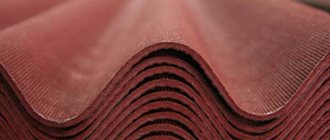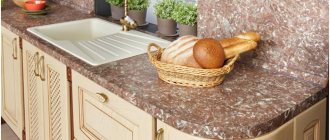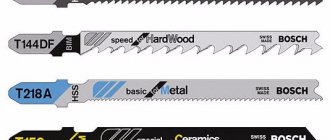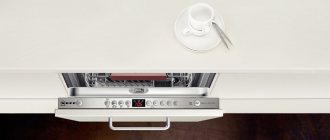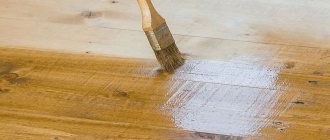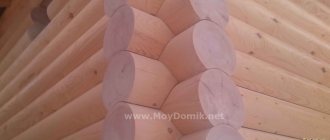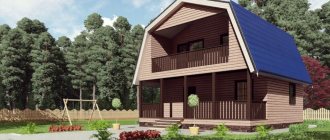Roofing corrugated sheeting has occupied a leading position in the building materials market for many years. Unique properties and practicality allow it to be used in a variety of conditions, and the price pleases with its accessibility.
But how to choose a suitable profiled sheet for a roof with a certain angle of inclination and operational features? What should the height of the corrugation be, are special grooves needed and what coating should be preferred? We will now answer these questions for you.
Application and features
Corrugated sheeting is a metal (usually steel) sheet on which a longitudinal profile of rectangular, trapezoidal or wavy shape is formed by cold rolling, and has a protective coating. Thanks to the extruded ribs, the material will acquire high longitudinal rigidity and strength, and the coating provides resistance to weathering.
Corrugated sheeting is used in construction as walls of utility and industrial buildings, for the construction of fences and various fences, as permanent formwork for foundations, as well as for the construction of auxiliary structures and temporary floors. Particularly noteworthy is the use of profiled sheets for covering single-pitched, gable, and hipped roofs. Lightweight sheets are used as roofing material, but have increased load-bearing capacity due to the height of the profile. It should exceed 20–21 mm. Roofing corrugated sheeting is used for arranging the roofs of country and country houses, outbuildings and garages, verandas, gazebos, temporary buildings of various types, as well as for creating canopies. It can be used at different slope angles, but with the fulfillment of an important condition: the lower the slope, the higher the profile height.
Important! The dependence of the amount of overlap of sheets on the steepness of the roof must be taken into account.
Corrugated sheet for roofing
Modern profiled galvanized steel decking is suitable for installation on roofs with a slope angle of more than 5°. The bulk of the profiled sheets sold are used by private homeowners when installing roofs. In addition, this material is used in the construction of buildings for various purposes:
- gazebos, canopies and canopies;
- small architectural forms - kiosks, garages, small shops and restaurants;
- large-sized objects - service stations, trade pavilions, hangars, modular buildings.
The profiled sheet produced differs in the shape of the wave, its height and the color of the coating.
The main purpose of roofing is to make the roof airtight and reliable. Corrugated roofing differs from other materials in its increased rigidity, wavy relief, thickness of the rolled products used in production and high load-bearing capacity.
Find out how to choose the right corrugated sheeting from our article - How to choose the best corrugated sheeting for the roof of a house.
Advantages of roofing corrugated sheets
The main advantages of corrugated sheets include:
- Ease. Its weight is 4.5–7 kg/m2, which makes the roof lightweight.
- Strength. Longitudinal stiffening ribs provide high resistance to mechanical damage. Compared to straight sheets, profiled material is at least 3 times stronger.
- Durability. Manufacturers claim service life of up to 25 years. In fact, corrugated roofing sheets will last 40–60 years. After this time, it can be used again for other purposes.
- Easy to install. Flexibility and ease of processing allow you to equip original roofs with configurations of varying complexity. Resistance to low temperatures and humidity makes it possible to install the roof in any season.
- Economical. The price of corrugated sheets is significantly lower than many other roofing materials. Light weight allows you to save on the construction of the foundation and rafter system. Costs for transport, loading and unloading and installation work are reduced.
- Aesthetics. The wide color palette of the polymer coating and the wavy relief help give the building’s exterior a finished look or focus attention on the unique roof.
- Fire safety, resistance to the destructive effects of corrosion and solar ultraviolet radiation, environmental friendliness.
Professional design and competent choice of material distinguish the building and its roof from a series of monotonous buildings
The disadvantages of corrugated sheeting include a low degree of sound insulation and susceptibility to corrosion due to mechanical or chemical damage to the protective layers. However, when the roof is insulated with mineral wool, the quality of its sound insulation increases noticeably, and regular inspection and timely repair of the roofing significantly extends its service life.
The main differences between roofing corrugated sheets and wall sheets
Metal profiled sheets are used for arranging facades, fences, walls, partitions and roofs. Roofing sheets have some distinctive features:
- To ensure sufficient strength of the roof, sheets with a wave height of at least 20 mm are used to cover it: from 21 mm to 57 mm.
- The roofing sheet has a trapezoidal profile, which ensures the free flow of large volumes of water during rainstorms and melting snow.
- The height of the profile crest is taken into account when installing the roof: the smaller the slope angle, the higher the sheet wave. Shallow wave decking when installed on a roof with a slight slope will require a larger overlap width when joining. Consequently, material consumption will increase, increasing the final cost of the coating.
- The edge of the corrugated sheet for roofing has a capillary groove, which provides additional protection against the flow of sediment and condensation water deep into the roofing pie.
In a low-quality profiled sheet, the capillary groove is deformed and becomes useless.
The capillary groove provides additional protection against moisture ingress into the roof space
The correct choice of profiled roof covering ensures its reliable protection against leaks.
Advantages and disadvantages
Profiled sheeting has the following advantages:
- Simplicity and ease of installation. The sheets are large in size and can be easily lifted to the top without the use of lifting mechanisms. You can install the roof with your own hands, without any special skills. Corrugated sheeting is cut and drilled with conventional tools. Standard fasteners are used.
- High longitudinal mechanical strength. It is provided by profiles that act as stiffeners.
- Versatility. The same sheets can be used for roofing, walls, fences, etc. Roofs of various types, configurations and slopes can be covered with corrugated sheeting.
- High resistance to atmospheric influences. Resistant to solar ultraviolet radiation, snow and wind loads. The coating reliably protects the metal from corrosion.
- Durability. When all installation requirements are taken into account, the service life of corrugated sheets exceeds 40 years.
- Reliable protection of structures from leakage. This is facilitated by the tight abutment of the sheets and overlapping installation.
- Environmental friendliness. In the manufacture of corrugated sheets, components capable of producing harmful emissions are not used.
- Fire safety. It is ensured by the non-flammability of the materials used.
- Ease. The specific gravity of corrugated sheeting is in the range of 5–9 kg per 1 m2.
- Attractive appearance. This is facilitated by a wide selection of materials in color and profile shape.
- Affordable prices. Corrugated sheeting is much cheaper than many roofing materials, and ease of installation reduces construction costs.
It is necessary to take into account the presence of certain disadvantages of the material:
- Noisy. During rain and wind, the noise level increases significantly. This circumstance requires the installation of reliable sound insulation when used for roofing residential buildings.
- High thermal conductivity. It is caused by a metal base. In summer, such a roof gets very hot, and in winter it causes a large loss of heat. Residential buildings require reliable thermal insulation.
- Condensate. Condensation accumulates on the inner surface of the roof, which requires the installation of a vapor barrier.
- Electrostaticity. Metal tends to accumulate an electrical charge, and to eliminate it, a reliable grounding (lightning rod) is necessary.
- Increased waste when covering roofs of complex shapes. It increases due to the need to cut large sheets.
- Active corrosion of the base when the protective coating is damaged. This danger occurs at cuts and places where fasteners are installed. When cutting corrugated sheets, you cannot use a grinder and welding machines, because... they can damage the coating with sparks.
In general, the advantages of the material are noticeably predominant. With proper installation and use of sound, heat, hydro and vapor barriers, disadvantages are reduced to a minimum.
Pros and cons of a corrugated roof
A parallel comparison of the advantages and disadvantages of corrugated sheets for roofing.
Advantages
- low price of material;
- the ability to do the installation yourself;
- resistance to environmental factors;
- resistance to corrosion (in the absence of mechanical damage and defects of the leaf core);
- light weight;
- safety (fire and environmental);
- the ability to be used for installation on a slope of any configuration and with any angle of inclination (even absolutely flat);
- the ability to set the direction of water movement from the roof;
- aesthetic appearance of the building.
Flaws
- corrugated sheeting makes noise during rain and, even more so, hail (to eliminate it, it is recommended to lay OSB boards or OSB plywood instead of sheathing);
- condensation accumulates on the surface (it is necessary to do good vapor and waterproofing);
- the corrugated sheet is prone to the accumulation of static electricity (grounding is required);
- Rust appears in the places of drilling and cutting (carefully treat such places with paint or Movil).
Types of corrugated sheets
Corrugated sheeting is divided into the following main types:
- Roofing or load-bearing type. The sheets are designated by the index H. They have increased strength and a reliable protective coating. It has an increased thickness of the metal sheet (1–1.2 mm) and profile height (more than 21 mm). An additional groove can be made in the center of the sheet to increase rigidity. It is this type of corrugated sheeting that is usually used for roofing.
- Wall type. It is designated by the letter C. It has less strength and is intended for walls, partitions, and fences. It uses a sheet of small thickness (no more than 0.7–0.8 mm), and the profile is made with a reduced height (less than 18 mm). It is not suitable for roofing, because... cannot withstand snow loads.
- Load-bearing wall or universal corrugated sheeting. Designated as NS. It is an intermediate option between the two above varieties. It is distinguished by fairly high strength, which makes it possible to use it for some roofs. For this variety, a steel sheet with a thickness of 0.81 mm is used. At the same time, the cost of the material is lower than that of N corrugated sheets. Most often, such sheets are used for the construction of fences and gates.
- Metal-polymer corrugated sheeting (MP). This is a combination of steel sheet and polycarbonate. It has good decorative properties, but is inferior to roofing sheets in strength. It is quite suitable for covering the roof area above the attic, when the transparent layer provides illumination inside the attic space. Each type of material has its own specific capabilities, which is reflected in the technical characteristics and cost.
Classification by protective coating
Depending on the material of the protective coating, the following types of corrugated sheets are distinguished:
- Polyester coated (PE). The surface of the sheets can be glossy or matte, and the layer thickness is 20 and 35 microns, respectively. The polymer is capable of operating at temperatures from -30 to +80 °C. An important advantage is high strength, reduced cost and variety of colors. The disadvantage is gradual fading under the sun, but the color fades evenly. The service life of the coating is approximately 25–30 years.
- With pural (Pural, PUR). The polymer is based on polyurethane, which provides high mechanical strength and resistance to aggressive influences. The service life exceeds 30 years and the color remains virtually unchanged. Disadvantage: increased cost. Layer thickness - 50 microns.
- Coated with plastisol (PVC). The polymer is made on the basis of PVC. Coating thickness - 0.2 mm. This is the cheapest, but quite reliable option. It is characterized by high elasticity and a variety of colors. Service life is 20–25 years.
- Coated with polydifluorionade (PVF2, PVDF). This is an innovative material designed for use in particularly severe climatic conditions under significant mechanical loads. This coating is the most durable. Has a service life of more than 40 years. The disadvantage is the high price.
Some manufacturers offer corrugated sheets with a proprietary coating. Their polymer has a special composition, which is kept secret. Choosing a coating is an important step. The service life of the entire sheet and the appearance of the roof depend on its quality and reliability. At the same time, the main characteristics are directly related to the price, and therefore you have to find the best option.
Methods for cutting corrugated roofing sheets
The main difficulty when cutting profiled sheets is maintaining the integrity of the decorative protective layer, the violation of which leads to active corrosion of the metal and shortens the service life of the roof. Hot methods, for example, using autogen, cannot be used, since the polymer coating will be destroyed by exposure to high temperatures. Traditionally, profiled sheets are cut:
- A jigsaw. A special feature of the process is that the fabric to be cut is installed vertically. Several helpers are needed to hold the cut parts. Low-power household tools can handle sheet thicknesses of no more than 0.2 mm. The torn edge requires additional processing.
- Hacksaw for metal. For a small amount of work - a good choice. Simple and safe, smooth cuts without jagged edges, but slowly and only in a straight line.
- Electric saw. Fast, neat, effortless. The inconvenience lies in the need for a table for work and the ability to cut only straight parts.
- Manual, electric or metal nibblers. A professional, expensive tool that cuts profiled sheets up to 1 mm thick quickly and accurately, without burrs, without bending the blade. Convenient to use when cutting thin strips.
- Bulgarian. For work, a special aluminum cutting disc with a maximum radius and a thickness of 1–1.6 mm is used. Thanks to teeth made of carbide materials, the cut edges are smooth and neat. An experienced craftsman will use a manual angle grinder (grinder) to cut out parts of the required geometric shape or quickly cut a dozen sheets at the same time.
Correct cutting of corrugated sheets is possible if the wave height of the material matches the diameter of the grinder's cutting wheel. The use of an abrasive wheel will destroy the protective coating of the roofing sheet.
When cutting corrugated sheets, professional roofers use attachments for a cordless drill, which allow them to cut and adjust the sheets during the process of installing roofing in hard-to-reach places.
When cutting profiled sheets, under no circumstances should you use a grinder with a cutting wheel.
To protect the edges at the joints, after cutting is completed, it is recommended to treat the cut areas with anti-corrosion mastic and paint them in the color of the decorative coating.
Video: what tools to cut corrugated sheets with
In high-quality galvanized steel, zinc molecules create a barrier on the cut that prevents oxidation of the rolled metal.
Marking of corrugated sheets
The brand of corrugated sheet includes a set of letters and numbers that provide information about its purpose, structure and basic parameters. Using this designation you can select the material. For example, corrugated sheet H32R-1000-0.5 is offered. The brand is deciphered as follows:
- the first letter indicates the type of corrugated sheeting: C - wall, N - roofing, load-bearing, NS - universal;
- numbers after the first letter - profile height (in the example - 32 mm);
- the letter R marks the presence of a capillary groove;
- the numbers after the dash are the useful width of the sheet excluding overlap (in the example - 1000 mm);
- the last numbers are the thickness of the steel sheet (in the example - 0.5 mm).
Specifications
When choosing corrugated roofing, you need to pay special attention to some technical parameters. The main ones are described in detail below.
Size
The length of the sheets can range from 50 cm to 14 m. The longer the sheet, the fewer sheets need to be installed, which speeds up construction. However, it is necessary to take into account the weight of the material and the length of the slope. The best option is to cover the entire slope with one sheet without cutting. In addition, long sheets are difficult to transport, and therefore corrugated sheets longer than 10 m are supplied only by special order. In private construction, the most popular length is 5–6 m. When choosing the width of the sheet, it must be taken into account that installation is carried out with an overlap of 4–10 cm. Taking this into account, the mark indicates only the useful width, i.e. sheet width minus overlap. The material must be selected according to the width of the slope so as to place a whole number of sheets on it (without cutting). Standard width of corrugated sheeting: useful - 1000 mm, total - 1051 mm.
Manufacturers can produce sheets of different widths.
An important parameter is the thickness of the steel sheet. It determines the load-bearing capacity, strength and reliability, but the weight also increases with increasing thickness. Standard thicknesses are 0.4, 0.45, 0.5, 0.55, 0.6, 0.7 and 0.8 mm. You can order corrugated sheets with a sheet of 1–1.2 mm. Most often, a thickness of 0.45–0.5 mm is recommended for roofing, but in regions with heavy snowfalls it should be increased as much as possible.
Weight
It increases with increasing thickness of the steel sheet. With a thickness of 0.5 mm, the weight is 5.14 kg, with 0.7 mm - 7.13 kg and with 0.8 mm - 8.11 kg/1 m2. The optimal weight is considered to be in the range of 4.5–5.5 kg/m2.
Life time
Durability depends on the presence and type of protective coating, as well as on production technology. The cheapest unprotected corrugated sheeting made of galvanized steel has a service life of no more than 12–15 years. Budget coverage options increase it to 25 years. The most reliable PVDF coating provides a durability of 40 years, and in reality the roof can last more than 50 years.
Color
The appearance of corrugated roofing provides a variety of color solutions. The most popular colors are brown, burgundy, green and blue in different shades. You can choose other tones. It is important that the color of the roof is harmoniously combined with the design of the facade of the building and the overall landscape design.
The listed criteria affect the reliability and attractiveness of the roof. The choice must be made taking into account the purpose and size of the structure, as well as specific climatic conditions.
Choice by quality
And now about how not to purchase a profile with a thickness of 0.5 mm, but to get 0.35 mm, which will corrode in the first year. What is the problem? In fakes.
When choosing a quality profile, pay attention to the following points:
- Sheet thickness. The finest items are clearly of dubious origin. Note that it is difficult to visually determine handicraft production, and even with a micrometer it will be possible to measure the thickness of the sheet together with the coating. So, for a roof, it is desirable that the thickness be 0.5 mm, zinc should be from 140 grams per square meter. What to do? Contact only trusted dealers or directly to the manufacturer.
- The quality of the raw materials used. For example, the Russian one produces profiles from metal of different origins. All raw materials have different degrees of galvanization, but within the limits of GOST. And you can require a quality certificate. And what the nameless profile with which the market is flooded is made from is a difficult question.
- Inner side of the sheet. There should be no streaks on it - only a uniform, pure color throughout the entire mass of the sheet. Coverage is very important! You don’t want the first hail to completely ruin the appearance of your roof, do you?
- Package. If the sheets are simply folded onto a regular block and hand-wrapped with film, this is not quality. When you bring (or will be delivered to you) such building material, you will find serious scratches due to improper protection, and you will end up rejecting at least one sheet from each package.
- Meeting the required criteria. We have already told you how to choose a specific profile to suit your needs - follow this. And under no circumstances trust unscrupulous sellers who will try to convince you to take a worse profile (after all, your neighbors supposedly bought the same one, and nothing happened). A wrong choice is also a bad profile!
Good luck with your purchase and successful installation!
What determines the durability and reliability of a roof?
The service life and reliability of the entire roof depend on the following factors:
- The correct choice of corrugated sheeting, taking into account the type, purpose and operating conditions. You should not save money and install a wall sheet on the roof, which may simply not withstand snow and wind loads.
- Compliance with all technological requirements during installation. This is, first of all, correct installation, reliable fastening and ensuring the required overlap. The height of the profile and ceiling is selected taking into account the slope angle of the slope.
- Presence of active corrosion areas. They appear when the protective coating is broken. The places where holes are drilled and cuts must be protected with special paint or spraying.
Important! The correct choice of material, compliance with the rules of installation and maintenance of the roof ensures an increased service life and reliably protects structures from precipitation.
Manufacturers
Consumers and experts in 2021 highlight the following best manufacturers of corrugated sheets:
- GRAND LINE (Russia). The company is rapidly developing a distribution network throughout Russia. Offers corrugated sheeting of all main types. The main coating is plastisol.
- Neva Steel. The company pays special attention to the quality of raw materials. High-quality rolled steel ArcelorMittal, Corus, Zalzgitter, Ruukki is used.
- Pokroff plant. Finnish technology is used in the production of profiled sheets. The steel is supplied by Severstal. The main coating is polyester.
- Ural Roofing Materials Plant (UZKM). The products are distinguished by ideal geometry and dimensional accuracy. For coating, purol, polyester, and plastisol are used. Original models with a velvety effect are offered.
- MetalProfile. The plant is considered the largest manufacturer of corrugated sheets in the Russian Federation. PURETAN, PURMAN and other branded polymers are used for coating. A wide range of products is offered.
Important! When purchasing corrugated sheets, it is important to pay attention to the manufacturer. Only trusted companies can guarantee quality and durability.
Types of corrugated sheet stiffeners
Corrugated sheeting can have the following types of waves:
- trapezoid;
- semicircle;
- triangle.
Trapezoidal waves are standard and are available on all types of flooring. Semicircle and triangle curves are used as additional stiffening ribs on the lower or upper sides of trapezoids to provide increased stability. They also serve as grooves to drain moisture from roofing materials.
Prices
The cost of corrugated sheeting depends on the thickness of the metal, coating material, production technology, manufacturer, special properties and design solutions. Service life and appearance are directly related to price, and therefore the buyer, based on his financial capabilities, chooses the optimal combination. The cheapest are sheets up to 0.5 mm thick with a profile of 20–30 and a PVC and polyester coating. The average price for them in the Russian Federation is 250–285 rubles per 1 m2. Similar products coated with pural will cost 510–560 rubles/m2.
Comparison with other materials
It cannot be said that in all cases corrugated roofing is most suitable. Compared to other roofing materials, it has its pros and cons. When compared with soft rolled materials, profiled sheets are noticeably inferior in heat and sound insulation abilities, but superior in strength and durability. It is much easier to cover roofs with complex shapes and slopes with steep slopes using roll materials. Compared to conventional tiles, corrugated roofing is much lighter, faster and easier to install, much cheaper, but inferior in appearance and thermal insulation properties. Regular slate corrugated sheeting is superior in design, strength, and the prices are comparable. The closest material is metal tiles. It has similar disadvantages, but is more attractive in appearance and is reinforced with transverse ribs. At the same time, it is more expensive.
Length of overlap of corrugated sheeting on the roof
The side edges of the profiled sheets should touch one or two waves, depending on the strength of the supporting structure of the roof and the expected load on the material.
An overlap of two waves is required in case of a small slope of the roof slope. This contact of the sheets will ensure the tightness and reliability of the roofing.
Horizontally, the sheets are laid with an overlap in one or two waves, vertically - 20 cm
The amount of overlap in centimeters is determined based on the degree of roof slope.
- When the roof is inclined less than 15 degrees, one edge of the sheet is overlapped by 20 cm over the other.
- If the roof slope is steeper (up to 30 degrees), then the corrugated sheeting is attached to the sheathing, making overlaps of 15–20 cm.
- With a roof slope of 35–50 degrees, contact of the edges of the sheets by 10–15 cm will be sufficient.
If it is necessary to make a horizontal overlap, stop at 20 centimeters. The resulting seams must be sealed using silicone sealant or bitumen mastic.
What else should you pay attention to?
Practice shows that in addition to the main criteria when choosing corrugated sheeting for a roof, you should pay attention to the following nuances:
- Appearance - absence of defects, peeling and unevenness of the coating.
- Leaf geometry. It should have clear lines and angles. Dimensional deviation should not exceed 0.1 mm.
- Profile geometry. In places where they overlap, the profile waves should fit tightly to each other.
- Edge quality. Notches and sagging are not allowed on cuts.
Important! When purchasing a product, you should check for manufacturer certificates and warranties. It is necessary to check the quality and integrity of the packaging.
What's the result?
We are convinced that corrugated sheeting produced by the Metal Profile Company is a practical, modern material for roof cladding. We also examined the main criteria for choosing corrugated sheeting - now you can independently determine which material is optimal for your facility. It's not difficult, just follow our recommendations.
Let your roof be original, aesthetic and durable!
* Detailed information about warranty periods for products can be obtained on the website in the “Documents” section.
The categories mentioned in the article are:
Profiled sheet

